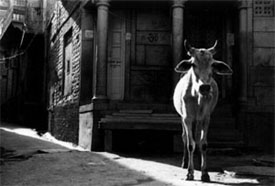Post from Michelle:
A cow lies lazily in the middle of a busy intersection. Seemingly oblivious to its awkward location, it chews nonchalantly as motorcycles, cars, rickshaws, and bicycles whiz past with only inches to spare. A truck driver turns his steering wheel wildly to avoid collision, barely missing a rickshaw. But no one honks or looks annoyed. The cow is a natural element is this city scene û like a rock in a fast flowing stream of water.
 A symbol of mother, fertility, and nurturing, cows are considered sacred animals in India. Beef is not eaten, leather is not worn, and in almost all of the country it is illegal to kill them. Cows wander freely in the streets until they are ready to be milked. They sit in groups along the road, stand defiantly in the middle of the street, cruise alleys, and hang in front of store windows. When a cow is ready to be milked, the owner brings it back to their house. Many of the cow horns are painted in bright colors, making it easy for the owner to distinguish it from others.
A symbol of mother, fertility, and nurturing, cows are considered sacred animals in India. Beef is not eaten, leather is not worn, and in almost all of the country it is illegal to kill them. Cows wander freely in the streets until they are ready to be milked. They sit in groups along the road, stand defiantly in the middle of the street, cruise alleys, and hang in front of store windows. When a cow is ready to be milked, the owner brings it back to their house. Many of the cow horns are painted in bright colors, making it easy for the owner to distinguish it from others.
Just in my short stay here, I see the cows usefulness to Indian society. The cows and bulls are used to pull heavy loads on carts and work the fields; milk is used for curd and butter, in the villages dried cow dung is used in fires for cooking or mixed with mud to build walls. The cows also serve as good garbage disposals, eating much of the litter piled high on the streets.
I love cows. I developed a special fondness for this creature when I attended college in rural Virginia, surrounded by farmland. Who can resist their large brown eyes, black and white patches, pink udders, and gentle moos? As an artist I am charmed by their shape, their silhouettes in the landscape.
Indian cows seem to know the gods have shined special favor on their lot. They roam around the city streets with a confident smugness, making trucks and buses ten times their size go around them. I might not fully understand the concept of worshipping cows, but I do know this: India would not be the same without cows on the streets. They add charm and extra spice to an already chaotic and vibrant scene.
 A symbol of mother, fertility, and nurturing, cows are considered sacred animals in India. Beef is not eaten, leather is not worn, and in almost all of the country it is illegal to kill them. Cows wander freely in the streets until they are ready to be milked. They sit in groups along the road, stand defiantly in the middle of the street, cruise alleys, and hang in front of store windows. When a cow is ready to be milked, the owner brings it back to their house. Many of the cow horns are painted in bright colors, making it easy for the owner to distinguish it from others.
A symbol of mother, fertility, and nurturing, cows are considered sacred animals in India. Beef is not eaten, leather is not worn, and in almost all of the country it is illegal to kill them. Cows wander freely in the streets until they are ready to be milked. They sit in groups along the road, stand defiantly in the middle of the street, cruise alleys, and hang in front of store windows. When a cow is ready to be milked, the owner brings it back to their house. Many of the cow horns are painted in bright colors, making it easy for the owner to distinguish it from others.Just in my short stay here, I see the cows usefulness to Indian society. The cows and bulls are used to pull heavy loads on carts and work the fields; milk is used for curd and butter, in the villages dried cow dung is used in fires for cooking or mixed with mud to build walls. The cows also serve as good garbage disposals, eating much of the litter piled high on the streets.
I love cows. I developed a special fondness for this creature when I attended college in rural Virginia, surrounded by farmland. Who can resist their large brown eyes, black and white patches, pink udders, and gentle moos? As an artist I am charmed by their shape, their silhouettes in the landscape.
Indian cows seem to know the gods have shined special favor on their lot. They roam around the city streets with a confident smugness, making trucks and buses ten times their size go around them. I might not fully understand the concept of worshipping cows, but I do know this: India would not be the same without cows on the streets. They add charm and extra spice to an already chaotic and vibrant scene.